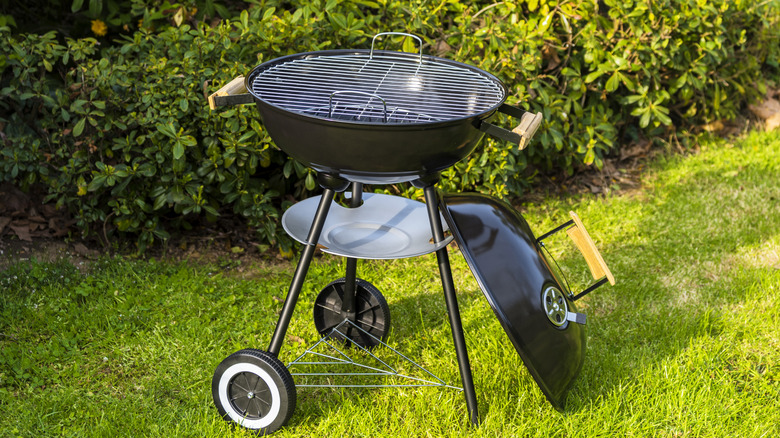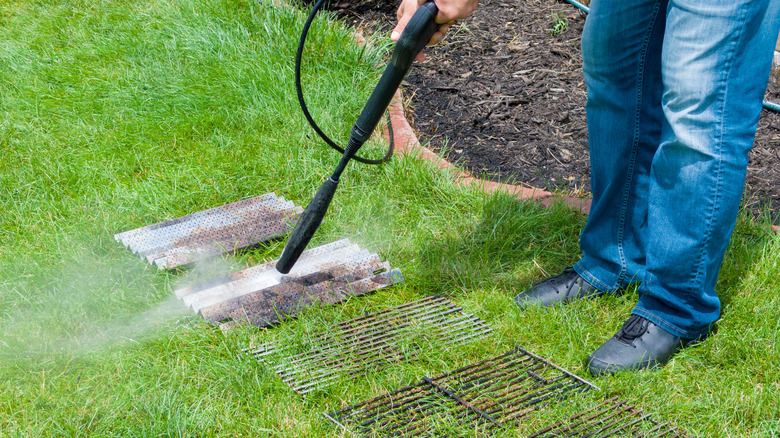Get Your Grill Good As New With The Help Of A Pressure Washer, Here's How
Most everyone enjoys a backyard cookout with friends and family with the gas grill taking center stage. Outdoor cooking is also a great way to keep the heat out of the kitchen when the weather is balmy. But after all that savory — and greasy — cooking takes place, you'll eventually need to give your trusty gas grill a thorough cleaning. The good news is that you can employ a pressure washer to help with the task and get it done in far less time in comparison to scrubbing it down by hand. Before you begin, especially if you're new to pressure washing, review all the safety suggestions in your owner's manual.
After that's out of the way, prep for pressure washer grill cleaning by disabling all energy sources. This includes unplugging electric starters, disconnecting propane tanks and setting them aside, or detaching the grill from the natural gas line. You'll also want to make sure that any hoses that connect to a tank or gas line are moved away from where you'll be spraying pressurized water to avoid damaging them. Believe it or not, you can cut a hose with a pressure washer which might lead to a gas leak once it's reconnected. After these safety measures are out of the way, you can move on to degreasing and cleaning your grill.
Degreasing and cleaning using a pressure washer
To remove the grease built up over a season of grilling tasty meats, you'll need to treat the inside of your grill with a degreaser before you start cleaning. Be sure you buy a degreasing product specifically designed for use with pressure washers and follow package instructions to dilute it appropriately. Add the prepared solution to the detergent tank of your pressure washer. Attach the detergent nozzle to the wand, and thoroughly spray all areas covered with greasy residue including the inside of the grill lid. You can let the degreaser sit while prepping your pressure washer for the next step.
Replace the detergent nozzle with a 15 or 25-degree nozzle. Pointing the nozzle to the ground, flush out any remaining detergent from the wand by depressing the trigger. You're then ready to do the actual pressure washing. Work from the top to the bottom cleaning the lid and all other areas you treated with degreaser. You can switch to a turbo nozzle if the grease build-up is severe. Allow the grill to air dry completely and apply a coating of vegetable oil to the grates before replacing the cover.
Cleaning just the grates and plates with a pressure washer
Some people prefer to err on the side of caution when it comes to cleaning pricey gas grills. If you don't feel comfortable cleaning your grill with pressure washing, you can still save some time cleaning the grates and heat plates to get them back in top shape without risking damage to the inner workings of your grill. After all, the grates are what your food touches, so that's the most important thing to keep clean. Heat plates can also become super greasy and grimy as you're grilling.
To clean these parts with your pressure washer, simply remove the grates and heat plates from your grill and place them against a sturdy surface like a brick wall or directly on the grass. Apply degreaser to them in the same way you would if you were cleaning the entire grill. After it has a chance to work for a few minutes, change the nozzle and wash away the loosened grime. Let them dry in the sun after they're thoroughly clean. Put the heat plates back in place and then reset the grates. Coat the grates with vegetable oil to prevent rust before stowing the grill away, and you'll be ready for your next backyard feast.

